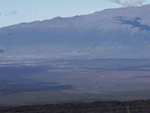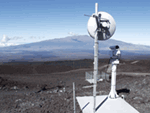More than two years after road access and electrical power to the Mauna Loa Observatory was cut off by lava flows, NOAA staff continue to make critical measurements of the atmosphere and other environmental variables at the remote site.
In 2023, observatory staff installed solar panels at the site and resumed some measurements, including the independent carbon dioxide monitoring programs run by the Global Monitoring Laboratory and Scripps Institution of Oceanography, as well as other atmospheric measurements.
Construction of a temporary road to access the observatory site is anticipated to begin in summer 2025.
Media can contact: Theo Stein (303) 819-7409 (theo.stein@noaa.gov)
Organization(s):
 Pacific Missile Range Facility, Naval Surface Warfare Center, Department of Navy
Pacific Missile Range Facility, Naval Surface Warfare Center, Department of Navy
What does this program measure?
A video surveillance system with microwave transmitter is used at MLO to observe and maintain range safety on Pohakuloa Training Area (PTA) when the U.S. Army conducts aerial bomb exercises.
How does this program work?
A video camera and infrared camera are mounted on a pedestal. Video images are collected and transmitted via microwave to the Army's Range Operations Center at the Pohakuloa Training Area Headquarters (located at the foot of Mauna Kea). The camera system operates continuously. General weather conditions at MLO are monitored remotely to ensure proper data collection.
Why is this research important?
The current means of maintaining range safety (visual observations and one fly over prior to the start of bombing maneuvers) requires improvements for upgrading the effectiveness of detecting unauthorized personnel and vehicles in the restricted area prior to lasing and resulting bomb impact.
Are there any trends in the data?
That is not applicable to this program.
How does this program fit into the big picture?
What is it's role in global climate change?
The essence of this project is to ensure range safety and maximize risk reduction for all bombing operations at PTA. The MLO site offers the best vantage point where live video observations of the bombin area can be collected and sent to the Pohakuloa Training Area Range Operations Center where immediate action can be implemented to locate and remove unauthorized personnel and vehicles in the hazard areas. The clear and open viewing from the MLO also provides the opportunity and added benfit for the PTA Range Operations Center to observe the bombing live, in real time so as to stop any bombing in progress if the "missed distance" to targets exceeds safety boundaries established to ensure the safety of adjacent activities outside of the PTA proper. Although this project was not meant to be a target scoring system, the features of this system provide for recordation of exercises and immediate feedback to the fighter pilot should any emergency situation occur during the exercise.
Comments and References
Lead Investigator(s):
Michael Castillo
808-335-4201
Mr. Daniel Momohara
808-335-4504
Mr. Eric Schreiner
909-273-5032
MLO Contact(s):
Darryl Kuniyuki
808-933-6965 (x236)
John Barnes
808-933-6965 (x222)
Web Site(s)
Date Started
July, 2006


